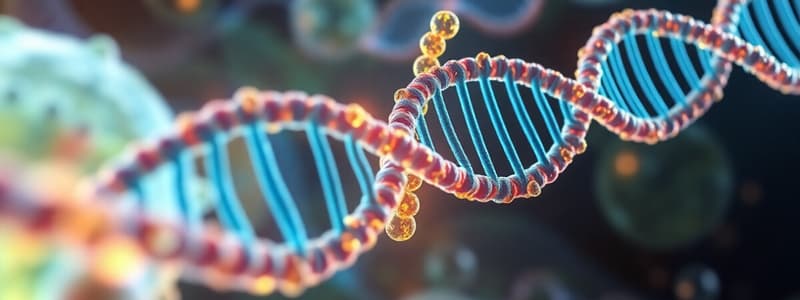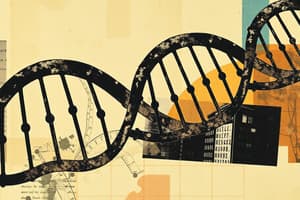Podcast
Questions and Answers
What effect does a decreased surface area to volume (SA/V) ratio have on a cell's efficiency?
What effect does a decreased surface area to volume (SA/V) ratio have on a cell's efficiency?
- It makes nutrient and waste exchange less efficient. (correct)
- It enhances nutrient uptake and waste disposal.
- It decreases the need for the cell to enter the cell cycle.
- It increases the rate of DNA replication.
During DNA replication, what role does primase play?
During DNA replication, what role does primase play?
- It brings RNA nucleotides complementary to the DNA template. (correct)
- It unwinds the DNA double helix.
- It synthesizes new DNA in a 3’ to 5’ direction.
- It connects Okazaki fragments together.
What is the correct order of steps in the transcription process?
What is the correct order of steps in the transcription process?
- RNA polymerase movement, binding mRNA, RNA synthesis.
- RNA synthesis, binding to promoter, RNA polymerase movement.
- Initiation, elongation, termination.
- Binding to promoter, RNA synthesis, RNA polymerase movement. (correct)
What is the role of tRNA in translation?
What is the role of tRNA in translation?
What is the significance of the stop codon in the translation process?
What is the significance of the stop codon in the translation process?
What does the leading strand do during DNA replication?
What does the leading strand do during DNA replication?
Which component of the ribosome plays a critical role in linking amino acids during protein synthesis?
Which component of the ribosome plays a critical role in linking amino acids during protein synthesis?
Which phase of the cell cycle is primarily associated with DNA replication?
Which phase of the cell cycle is primarily associated with DNA replication?
What initiates the transcription process at the promoter region?
What initiates the transcription process at the promoter region?
What is the first amino acid added to a growing polypeptide chain during translation?
What is the first amino acid added to a growing polypeptide chain during translation?
Flashcards
SA/V Ratio
SA/V Ratio
The ratio of a cell's surface area to its volume. It's important because it affects how efficiently nutrients can enter and waste can exit a cell.
Cell Cycle
Cell Cycle
The process where a larger cell divides into two smaller cells. It's triggered when the SA/V ratio gets too small, making it hard for the cell to function efficiently.
Primase
Primase
An enzyme crucial for DNA replication. It helps in creating short RNA sequences (primers) that act as starting points for DNA polymerase to begin copying DNA.
Leading Strand
Leading Strand
Signup and view all the flashcards
Okazaki Fragments
Okazaki Fragments
Signup and view all the flashcards
Lagging Strand
Lagging Strand
Signup and view all the flashcards
Translation
Translation
Signup and view all the flashcards
tRNA
tRNA
Signup and view all the flashcards
rRNA
rRNA
Signup and view all the flashcards
mRNA
mRNA
Signup and view all the flashcards
Study Notes
Surface Area to Volume Ratio (SA/V) and Cell Cycle
- A decreasing SA/V ratio in a cell makes nutrient and waste transport less efficient due to lower surface area relative to volume.
- A small SA/V ratio in large cells triggers signals for cell division.
- Conversely, an increasing SA/V ratio (smaller cells) simplifies nutrient/waste management.
DNA Replication
- Primase: An enzyme crucial in DNA replication, adding RNA nucleotides complementary to the DNA template.
- Leading Strand: Synthesized continuously from the 5' to 3' direction on the template strand.
- Okazaki Fragments: Short DNA segments formed discontinuously on the lagging strand, synthesised from the 5' to 3' direction in separate sections.
- Lagging Strand: New DNA synthesized discontinuously in short segments opposite the replication fork.
Translation (RNA to Protein)
- tRNA (Transfer RNA): Carries amino acids to ribosomes for protein synthesis.
- rRNA (Ribosomal RNA): Forms ribosomes, aiding in protein synthesis and amino acid linking.
- mRNA (Messenger RNA): Carries the genetic code from DNA to ribosomes for protein synthesis.
- Methionine: The initial amino acid in protein synthesis.
- Translation Steps:
- mRNA binds to the small ribosomal subunit.
- Ribosome formation and subsequent tRNA entry.
- Peptide bond formation.
- Translocation (ribosome movement along mRNA).
- Stop codon signals translation termination.
Transcription (DNA to RNA)
- Promoter: DNA region where transcription begins.
- Transcription Steps:
- RNA polymerase constructs RNA.
- RNA polymerase moves along the DNA in a 3' to 5' direction, producing a 3' to 5' RNA molecule.
Studying That Suits You
Use AI to generate personalized quizzes and flashcards to suit your learning preferences.




